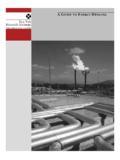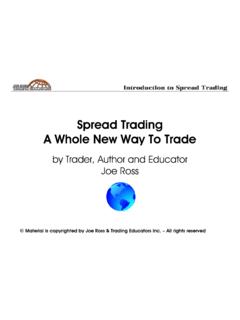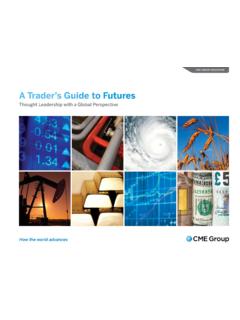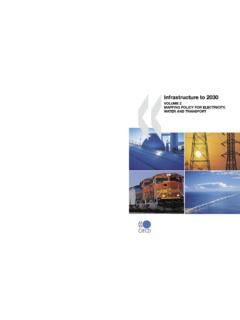Transcription of CBOT Soybean Crush - KIS FUTURES
1 cbot Soybean Crush Reference Guide Introduction In the Soybean industry, the term Crush ' refers both to a physical process as well as a value calculation. The physical Crush is the process of converting soybeans into the by-products of Soybean meal and Soybean oil. The Crush spread is a dollar value quoted as the difference between the combined sales values of the products and the cost of the raw soybeans. This value is traded in the cash or FUTURES market based on expectations of future price movement of soybeans versus the components. The relationship between prices in the cash market is commonly referred to as the Gross Processing Margin (GPM). The Crush value traded in the FUTURES market (often referred to as the Board Crush ) is an intercommodity spread transaction in which Soybean FUTURES are bought (or sold) and Soybean meal and oil FUTURES are sold (or bought).
2 The Crush spread is often used by processors to hedge the purchase price of soybeans and the sales prices of the Soybean meal and oil. It also offers many opportunities for speculators, as the spread relationship between the raw material and its products varies over time. The November/December Crush (buying/selling November soybeans and selling/buying December Soybean meal and oil FUTURES ) is used to hedge new-crop gross processing margins because the November/December prices often reflect the market's perception of conditions in the new Soybean crop year. Many seasonal, cyclical, and fundamental factors affect the Soybean Crush spread; for example, Soybean prices are typically lowest at harvest and trend higher during the year as storage, interest, and insurance costs accumulate over time. Changes in demand for high protein feed over the course of the year and depletion of South American Soybean stocks during the late fall and winter months are additional factors than can affect the Crush spread; others include crop size and yields, world demand, carryover stocks, Third World purchases of edible oils, Malaysian palm oil production, European meal demand, government programs, and weather.
3 Fundamental and technical analysis can be used to help forecast the potential for repetitive market behavior, although there are many unpredictable elements (such as weather) that affect the Crush spread. The historical data provided in this publication highlight some of the trends and market conditions that have prevailed in the Crush spread over the past decade. 1. WHY TRADE SPREADS? Those who trade spreads, which are defined as the buying of one or more FUTURES contract(s) and selling of a different but related FUTURES contract(s), typically do so for two important reasons lower risk and attractive margin rates. Lower Risk Spreads usually offer lower risk1 than outright FUTURES positions, since the prices of related commodities exhibit a strong tendency to move up or down together. This relationship may offer protection against losses that can arise from unexpected or extreme price volatility.
4 Attractive Margin Rates Since spreads are usually less risky than outright positions, spread margin rates are generally lower than those of the combined outright positions. Spread margin rates apply even if a trader legs into (trade entry for the spread components, or legs, are not simultaneous) the spread over time. 1. An intercommodity spread may not always be less risky than an outright position. For example, if a trader is long November soybeans and short December meal and oil, and the meal and oil prices increase while Soybean prices decrease over the life of the position, the trader might lose money on all sides (legs) of the spread. 2. THE Crush SPREAD. The Crush spread is quoted as the difference between the combined sales value of Soybean meal and oil and the price of soybeans. Soybeans are traded in cents per bushel, Soybean meal in dollars per short ton, and Soybean oil in cents per pound because of these differences in units, conversion of meal and oil prices to cents per bushel is necessary to determine the relationship of the three commodities and potential trading opportunities.
5 When a bushel of soybeans weighing 60 pounds is crushed, the typical result is 11 pounds of Soybean oil, 44 pounds of 48% protein Soybean meal, 4 pounds of hulls, and 1 pound of waste. If the hulls are retained, the result is 48. pounds of 44% protein Soybean meal. In October 1992, the Chicago Board of Trade revised the Soybean meal FUTURES contract specifications from a 44% protein standard to 48%. protein Soybean meal. 3. To Convert Prices into Cents Per Bushel Soybeans: No conversion required Soybean Meal: 44 lbs (48% protein meal per bushel) / 2,000 lbs (per ton) = x price of meal Soybean Oil: 11 lbs (oil per bushel) x price of oil Once these commodities have been converted to a price per bushel, individual crushing facilities can compare these numbers to data on their own production efficiency to determine the profitability of processing this calculation is referred to as the Gross Processing Margin (GPM) or Crush .
6 To Calculate the Crush or GPM. [(Price of Soybean Meal ($/short ton) x .022) + Price of Soybean Oil ( /lb) x 11] Price of Soybeans ($/bu.). Typically, crushing activity is expanded or reduced to maintain sufficient profitability; the GPM is used to gauge the relative costs of production. When the margin exceeds processing costs, crushers will most likely process more soybeans; when the margin falls below processing costs, processors may scale back their operations. An Example of Calculating the Crush To illustrate the calculation of the Crush , assume the following prices and values for November/December FUTURES contracts: November Soybean FUTURES : $ per bushel (5,000 bushels). December Soybean meal FUTURES : $ per short ton (100 short tons). December Soybean oil FUTURES : $ per pound (60,000 pounds). Step 1 Convert Prices into dollars per bushel: Soybean meal: $ x.
7 022 = $ per bushel Soybean oil: $ x 11 = $ per bushel Step 2 Subtract the cost of soybeans from the combined sales value of the products: Soybean meal + oil ($ + $ ): $ Soybeans $ Crush $ 4. Crush SPREAD TERMINOLOGY. The difference between the price of soybeans and the sales value of Soybean meal and oil can vary over time. Expectations about the behavior of the spread offer different trading strategies, depending upon whether one expects the difference to widen or narrow.. A Narrowing Crush Spread occurs when the price of soybeans rises relative to the sales price of Soybean oil and meal. When this occurs, the spread declines. A trader expecting a narrowing Crush spread puts on a Crush spread buying Soybean FUTURES and selling Soybean meal and oil FUTURES . An Example of Trading a Narrowing Crush Spread Put on Crush Spread Lift Crush Spread September 28 October 10.
8 Buy Sell November Soybean FUTURES November Soybean FUTURES 1 contract at $ per bushel 1 contract at $ per bushel Sell Buy December Soybean Meal December Soybean Meal 1 contract at $ per short ton 1 contract at $ per short ton December Soybean Oil December Soybean Oil 1 contract at $ per pound 1 contract at $ per pound Results Soybeans: $ Loss ($ $ ) x 5,000 (bu) = ($ ). Soybean meal: $ Gain ($ $ ) x 100 (s. ton) = $ Soybean oil: $ Gain ($ $ ) x 60,000 (lbs) = $2, Net gain: $2, 5. A Widening Crush Spread occurs when the sales price of Soybean oil and meal rise relative to the price of soybeans. When this occurs, the spread increases. A trader expecting a widening Crush spread puts on a reverse Crush spread selling Soybean FUTURES and buying Soybean meal and oil FUTURES . An Example of Trading a Widening or Reverse Crush Spread Put on Reverse Crush Spread Lift Reverse Crush Spread July 10 October 1.
9 Sell Buy November Soybean FUTURES November Soybean FUTURES 1 contract at $ per bushel 1 contract at $ per bushel Buy Sell December Soybean Meal December Soybean Meal 1 contract at $ per short ton 1 contract at $ per short ton December Soybean Oil December Soybean Oil 1 contract at $ per pound 1 contract at $ per pound Results Soybeans: $ Loss ($ $ ) x 5,000 (bu) = ($ ). Soybean meal: $ Gain ($ $ ) x 100 (s. ton) = $1, Soybean oil: $ Gain ($ $ ) x 60,000 (lbs) = $ Net gain: $ 6. TRADING THE Crush SPREAD OR Crush PACKAGE . Although the previous examples have used a one-to-one ratio of FUTURES contracts (one Soybean FUTURES contract to every Soybean meal and Soybean oil contract), the Crush (and reverse Crush ). can also be traded as a package, in which a bid or offer is made for a particular Crush value rather than making individual trades in each of the spread legs.
10 The Crush package is based on a ratio of contracts that more accurately approximates the equivalent yields of Soybean meal and oil generated from one bushel of soybeans. When trading a Crush package, the trader buys or sells the equivalent of 50,000 bushels of each commodity (after using the unit conversion factors previously discussed), or 10 Soybean contracts, 11 Soybean meal contracts, and 9 Soybean oil contracts. This is the smallest ratio of contracts that accurately represents the equivalent yields of the three commodities. The Crush Package . Soybeans 50,000 bushels = 10 Soybean contracts (at 5,000 bushels per contract). Soybean Meal 50,000 bushels of soybeans x 44 lbs / 48% Meal = 2,200,000 lbs of meal 2,200,000 lbs / 2,000 lbs/short ton = 1,100 short tons of meal = 11 Soybean meal contracts (at 100 short tons per contract).










